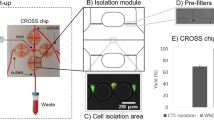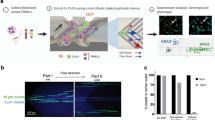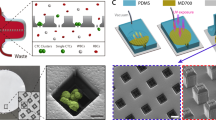Abstract
Viable tumour-derived epithelial cells (circulating tumour cells or CTCs) have been identified in peripheral blood from cancer patients and are probably the origin of intractable metastatic disease1,2,3,4. Although extremely rare, CTCs represent a potential alternative to invasive biopsies as a source of tumour tissue for the detection, characterization and monitoring of non-haematologic cancers5,6,7,8. The ability to identify, isolate, propagate and molecularly characterize CTC subpopulations could further the discovery of cancer stem cell biomarkers and expand the understanding of the biology of metastasis. Current strategies for isolating CTCs are limited to complex analytic approaches that generate very low yield and purity9. Here we describe the development of a unique microfluidic platform (the ‘CTC-chip’) capable of efficient and selective separation of viable CTCs from peripheral whole blood samples, mediated by the interaction of target CTCs with antibody (EpCAM)-coated microposts under precisely controlled laminar flow conditions, and without requisite pre-labelling or processing of samples. The CTC-chip successfully identified CTCs in the peripheral blood of patients with metastatic lung, prostate, pancreatic, breast and colon cancer in 115 of 116 (99%) samples, with a range of 5–1,281 CTCs per ml and approximately 50% purity. In addition, CTCs were isolated in 7/7 patients with early-stage prostate cancer. Given the high sensitivity and specificity of the CTC-chip, we tested its potential utility in monitoring response to anti-cancer therapy. In a small cohort of patients with metastatic cancer undergoing systemic treatment, temporal changes in CTC numbers correlated reasonably well with the clinical course of disease as measured by standard radiographic methods. Thus, the CTC-chip provides a new and effective tool for accurate identification and measurement of CTCs in patients with cancer. It has broad implications in advancing both cancer biology research and clinical cancer management, including the detection, diagnosis and monitoring of cancer10.
This is a preview of subscription content, access via your institution
Access options
Subscribe to this journal
Receive 51 print issues and online access
$199.00 per year
only $3.90 per issue
Buy this article
- Purchase on Springer Link
- Instant access to full article PDF
Prices may be subject to local taxes which are calculated during checkout




Similar content being viewed by others
References
Cristofanilli, M. et al. Circulating tumor cells, disease progression, and survival in metastatic breast cancer. N. Engl. J. Med. 351, 781–791 (2004)
Steeg, P. S. Tumor metastasis: mechanistic insights and clinical challenges. Nature Med. 12, 895–904 (2006)
Gupta, G. P. & Massague, J. Cancer metastasis: building a framework. Cell 127, 679–695 (2006)
Reya, T., Morrison, S. J., Clarke, M. F. & Weissman, I. L. Stem cells, cancer, and cancer stem cells. Nature 414, 105–111 (2001)
Mocellin, S., Hoon, D., Ambrosi, A., Nitti, D. & Rossi, C. R. The prognostic value of circulating tumor cells in patients with melanoma: a systematic review and meta-analysis. Clin. Cancer Res. 12, 4605–4613 (2006)
Smerage, J. B. & Hayes, D. F. The measurement and therapeutic implications of circulating tumour cells in breast cancer. Br. J. Cancer 94, 8–12 (2006)
Rolle, A. et al. Increase in number of circulating disseminated epithelial cells after surgery for non-small cell lung cancer monitored by MAINTRAC(R) is a predictor for relapse: A preliminary report. World J. Surg. Oncol. 3, 18 (2005)
Braun, S. & Marth, C. Circulating tumor cells in metastatic breast cancer—toward individualized treatment? N. Engl. J. Med. 351, 824–826 (2004)
Zieglschmid, V., Hollmann, C. & Bocher, O. Detection of disseminated tumor cells in peripheral blood. Crit. Rev. Clin. Lab. Sci. 42, 155–196 (2005)
Bell, D. W. & Haber, D. A. A blood-based test for epidermal growth factor receptor mutations in lung cancer. Clin. Cancer Res. 12, 3875–3877 (2006)
Kahn, H. J. et al. Enumeration of circulating tumor cells in the blood of breast cancer patients after filtration enrichment: correlation with disease stage. Breast Cancer Res. Treat. 86, 237–247 (2004)
Krivacic, R. T. et al. A rare-cell detector for cancer. Proc. Natl Acad. Sci. USA 101, 10501–10504 (2004)
Racila, E. et al. Detection and characterization of carcinoma cells in the blood. Proc. Natl Acad. Sci. USA 95, 4589–4594 (1998)
Fu, A. Y., Spence, C., Scherer, A., Arnold, F. H. & Quake, S. R. A microfabricated fluorescence-activated cell sorter. Nature Biotechnol. 17, 1109–1111 (1999)
Davis, J. A. et al. Deterministic hydrodynamics: taking blood apart. Proc. Natl Acad. Sci. USA 103, 14779–14784 (2006)
Huang, L. R., Cox, E. C., Austin, R. H. & Sturm, J. C. Continuous particle separation through deterministic lateral displacement. Science 304, 987–990 (2004)
Chang, W. C., Lee, L. P. & Liepmann, D. Biomimetic technique for adhesion-based collection and separation of cells in a microfluidic channel. Lab Chip 5, 64–73 (2005)
Whitesides, G. M. The origins and the future of microfluidics. Nature 442, 368–373 (2006)
Hong, J. W. & Quake, S. R. Integrated nanoliter systems. Nature Biotechnol. 21, 1179–1183 (2003)
Toner, M. & Irimia, D. Blood-on-a-chip. Annu. Rev. Biomed. Eng. 7, 77–103 (2005)
Dittrich, P. S. & Manz, A. Lab-on-a-chip: microfluidics in drug discovery. Nature Rev. Drug Discov. 5, 210–218 (2006)
El-Ali, J., Sorger, P. K. & Jensen, K. F. Cells on chips. Nature 442, 403–411 (2006)
Went, P. T. et al. Frequent EpCam protein expression in human carcinomas. Hum. Pathol. 35, 122–128 (2004)
Balzar, M., Winter, M. J., de Boer, C. J. & Litvinov, S. V. The biology of the 17–1A antigen (Ep-CAM). J. Mol. Med. 77, 699–712 (1999)
Rao, C. G. et al. Expression of epithelial cell adhesion molecule in carcinoma cells present in blood and primary and metastatic tumors. Int. J. Oncol. 27, 49–57 (2005)
Smirnov, D. A. et al. Global gene expression profiling of circulating tumor cells. Cancer Res. 65, 4993–4997 (2005)
Therasse, P. et al. New guidelines to evaluate the response to treatment in solid tumors. European Organization for Research and Treatment of Cancer, National Cancer Institute of the United States, National Cancer Institute of Canada. J. Natl. Cancer Inst. 92, 205–216 (2000)
Terstappen, L. W. et al. Flow cytometry–principles and feasibility in transfusion medicine. Enumeration of epithelial derived tumor cells in peripheral blood. Vox Sang. 74 (suppl. 2). 269–274 (1998)
Kraeft, S. K. et al. Reliable and sensitive identification of occult tumor cells using the improved rare event imaging system. Clin. Cancer Res. 10, 3020–3028 (2004)
Allard, W. J. et al. Tumor cells circulate in the peripheral blood of all major carcinomas but not in healthy subjects or patients with nonmalignant diseases. Clin. Cancer Res. 10, 6897–6904 (2004)
Drummond, J. E. & Tahir, M. I. Laminar viscous flow through regular arrays of parallel solid cylinders. Int. J. Multiphase Flow 10, 515–539 (1984)
Murthy, S. K., Sin, A., Tompkins, R. G. & Toner, M. Effect of flow and surface conditions on human lymphocyte isolation using microfluidic chambers. Langmuir 20, 11649–11655 (2004)
Acknowledgements
We thank A. Amin for technical assistance in running experiments, O. Hurtado for clean room work, S. Murthy for surface chemistry, L. Romonosky for cell counting, D. Hyde for digital pictures and D. Poulsen for illustrations. We are also grateful to R. Kapur and his team for technical assistance. The authors acknowledge funding from the National Institutes of Health (to M.T.), and the Doris Duke Distinguished Clinical Scientist Award (to D.A.H.).
Author Contributions S.N., L.V.S., R.G.T., D.A.H. and M.T. designed and conducted the study. S.M., D.W.B. and L.U. performed gene expression analyses; D.I. contributed to the microfluidic system. M.R.S., E.L.K. and P.R. acquired clinical samples. U.J.B. provided input on cytopathology; A.M. performed statistical analysis; and S.D. performed radiology measurements. S.N., L.V.S., D.W.B., S.M., D.I., D.A.H. and M.T. participated in data analysis and writing of the manuscript.
Author information
Authors and Affiliations
Corresponding author
Ethics declarations
Competing interests
At the time the reported study was performed, M.T., R.G.T. and Massachusetts General Hospital (MGH) had significant equity holdings or similar interests in licensees from MGH for technology described in this manuscript. Before final submission for publication, recognizing Partners HealthCare System and Harvard Medical School policies on conflicts of interest, M.T., R.G.T. and MGH relinquished all such interests.
Supplementary information
Supplementary Information
The file contains Supplementary Figures S1-S6 with Legends and Supplementary Tables S1-S2. (PDF 852 kb)
Rights and permissions
About this article
Cite this article
Nagrath, S., Sequist, L., Maheswaran, S. et al. Isolation of rare circulating tumour cells in cancer patients by microchip technology. Nature 450, 1235–1239 (2007). https://doi.org/10.1038/nature06385
Received:
Accepted:
Issue Date:
DOI: https://doi.org/10.1038/nature06385
This article is cited by
-
Cancer-related cells and oncosomes in the liquid biopsy of pancreatic cancer patients undergoing surgery
npj Precision Oncology (2024)
-
Label-free cancer cell separation from whole blood on centrifugal microfluidic platform using hydrodynamic technique
Microfluidics and Nanofluidics (2024)
-
Label-free microfluidic chip for segregation and recovery of circulating leukemia cells: clinical applications in acute myeloid leukemia
Biomedical Microdevices (2024)
-
Blood-based liquid biopsy: insights into early detection, prediction, and treatment monitoring of bladder cancer
Cellular & Molecular Biology Letters (2023)
-
Clinical application and detection techniques of liquid biopsy in gastric cancer
Molecular Cancer (2023)
Comments
By submitting a comment you agree to abide by our Terms and Community Guidelines. If you find something abusive or that does not comply with our terms or guidelines please flag it as inappropriate.



